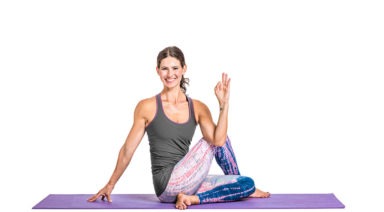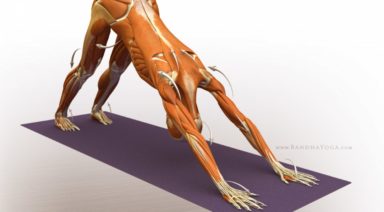Extended Side Angle Pose: Utthita Parsvakonasana

Utthita parsvakonasana (oo-TEE-tah PARZ-vuh-ko-NAHS-uh-nuh) is a standing pose that stretches the legs, knees, hips, and ankles while increasing endurance and stamina.
SANSKRIT
- Utthita: extended
- Parsva: side
- Kona: angle
- Asana: pose
PHYSICAL BENEFITS
- Strengthens your thighs, hips, knees, and ankles.
- Stretches your groin, back, spine, waist, ankles, and shoulders.
ENERGETIC BENEFITS
- Increases endurance and stamina.
PREP POSES
- Downward facing dog | Adho mukha svanasana
- Warrior II | Virabhadrasana II
- Low lunge | Anjaneyasana
SEQUENTIAL POSES
- Triangle pose | Trikonasana
- Half moon pose | Ardha chandrasana
- Bound extended side angle | Baddha parsvakonasana
COUNTER POSES
- Pyramid pose | Parsvottanasana
- Standing forward fold | Uttanasana
- Reverse warrior | Viparita virabhadrasana
ADJUSTMENTS/MODIFICATIONS
- Rest your forearm on the top of your front thigh. Draw your shoulders away from your ears and stay engaged in the sides of the torso to prevent collapsing toward the ground.
- Place a block under your bottom hand to bring the ground closer to you.
- Keep your gaze forward or down to the floor to invite more space in the neck.
STEP-BY-STEP
- Begin in warrior II pose with your right foot forward.
- Reach your right arm toward the top of your mat, extending through the sides of your torso. When you reach as far as you can, lower your right hand down and left hand toward the ceiling, both palms facing the left side of your mat.
- Draw both shoulders away from your ears. Square your shoulders to the left side of your mat.
- Hold for 3-5 breaths, then return to warrior II and release. Repeat on the other side.
###Legal Disclaimer Before participating in any exercise program or using any fitness products or services that may be described and/or made accessible in or through the Gaia Website and/or the Services, you should consult with a physician or other healthcare provider. Read more about Gaia’s Terms Of Use.
Ardha Matsyendrasana: Half Lord of the Fishes Pose

ADJUSTMENTS | BENEFITS | SEQUENCING | SANSKRIT | STEPS
Ardha matsyendrasana (ARE-dah MOT-see-en-DRAHS-ah-nah) is an approachable twist that opens the shoulders and chest. A good antidote for too much sitting and symptoms that come with overusing technology, half lord of the fishes pose has the ability to increase energy in the body while also stoking the digestive fire in your belly.
Philosophy + Origin
Matsyendra is often recognized as one of the original founders of hatha yoga in yogic mythology. He was said to be a baby who was thrown into the ocean after his parents rejected him. The story of Matsyendra reminds us that it’s often the parts of our personal stories we don’t like or don’t want to accept that can be the most beneficial, especially on the path to becoming a yogi or yogini. Rather than conceptualizing the twist to be a purge of what is unwanted or unnecessary, think of the detoxification as a purification, an opportunity to take what was once viewed or understood as “bad” and transform it into something that is helpful on your personal journey.




































